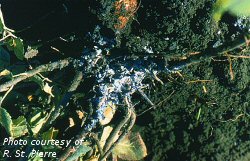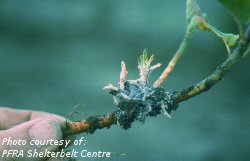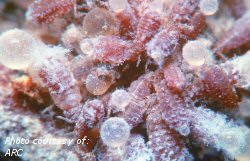Woolly Elm Aphid (Eriosoma Americanum)

Woolly elm infested saskatoon root

Woolly elm aphids on roots of saskatoon

Woolly elm aphid damage on saskatoon

Woolly elm aphids
Host Plants And Distribution
The woolly elm aphid requires two hosts for its development each year. The two hosts are elm (Ulmus americana) and saskatoon. This aphid is found throughout North America wherever its host plants are found.
Biology
The woolly elm aphid overwinters as an egg in bark crevices on elm. In the spring eggs hatch and female aphids emerge. These females feed on foliage, causing the leaves to curl, forming a protective enclosure. The females mature within the leaf curl and give rise to a large second generation of females, most of which develop into winged aphids. These winged aphids migrate from elm to saskatoon in late June until early July. Once a winged female lands on a saskatoon plant, they immediately deposit about 14 female nymphs on the underside of the leaves. These tiny yellow aphid nymphs make their way down the plant to the roots beneath the soil surface. Underground, they will become light-grey to blue, soft-bodied aphids, which will establish a colony that will produce two more generations of females. In August and into September, winged adult females are again produced that migrate back to the elms. Here, male and female aphids are produced that mate, and the females lay the eggs that overwinter.
Symptoms And Damage
Saskatoon plants damaged by the woolly elm aphid may not show any symptoms until the following spring. In spring, damaged plants will break bud, produce a few small leaves and may die. Saskatoon plantings are susceptible in the year of establishment, but are most susceptible in the second and third growing season. Older plants may support populations of the aphid, but are not likely to be killed. Vigour and fruit production by older plants will be reduced by the aphid.
Scouting Techniques
Roots infested with woolly elm aphids will appear white and fungus-like with a purplish/blue hue. Scouting is accomplished by inspection of roots. Dig a 15 cm trench in a semicircle about 30 cm away from the seedling. Carefully remove the soil from the roots, moving from the edge of the trench toward the base of the plant. If aphids are present, there will be a purplish/blue to bluish-white discolouration around parts of the root. Infestations can be quite variable, with populations being vastly different on adjacent plants. Damage is similar to that caused by the round-headed apple tree borer, but the woolly elm aphid does not cause the stem to crack and split. Yellow sticky traps may also be used to monitor aphid migrations.
Economic Thresholds
Economic threshold levels have not been established yet for the woolly elm aphid, but in the first three years of establishment, the plants are very susceptible to attack.

